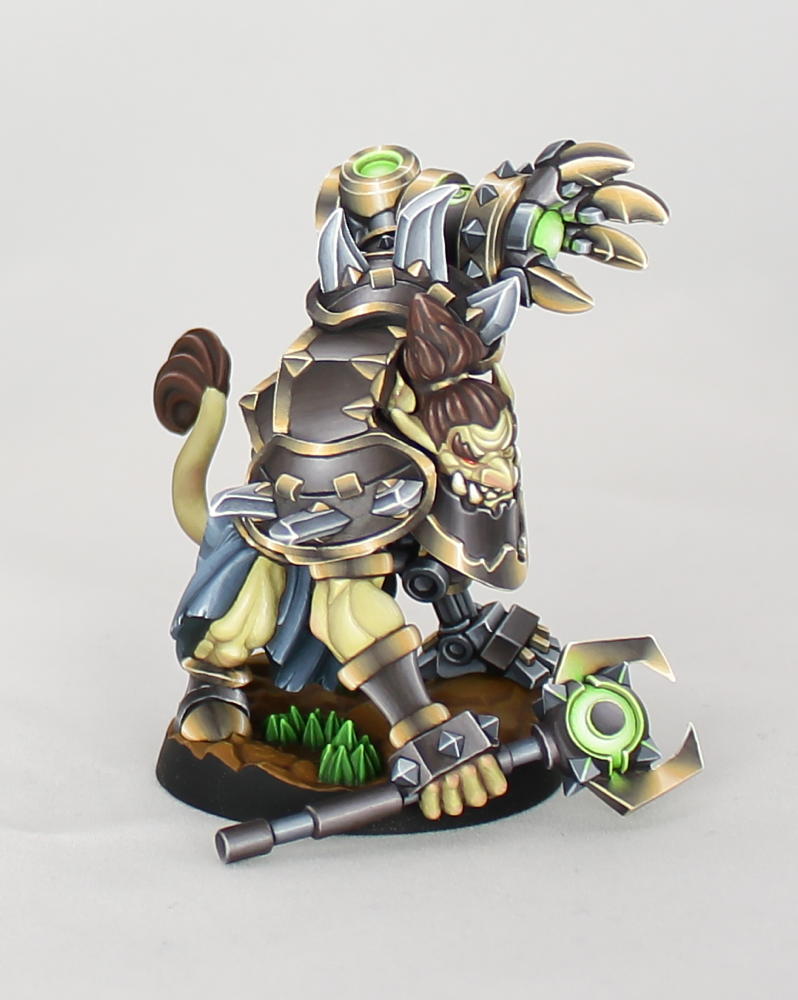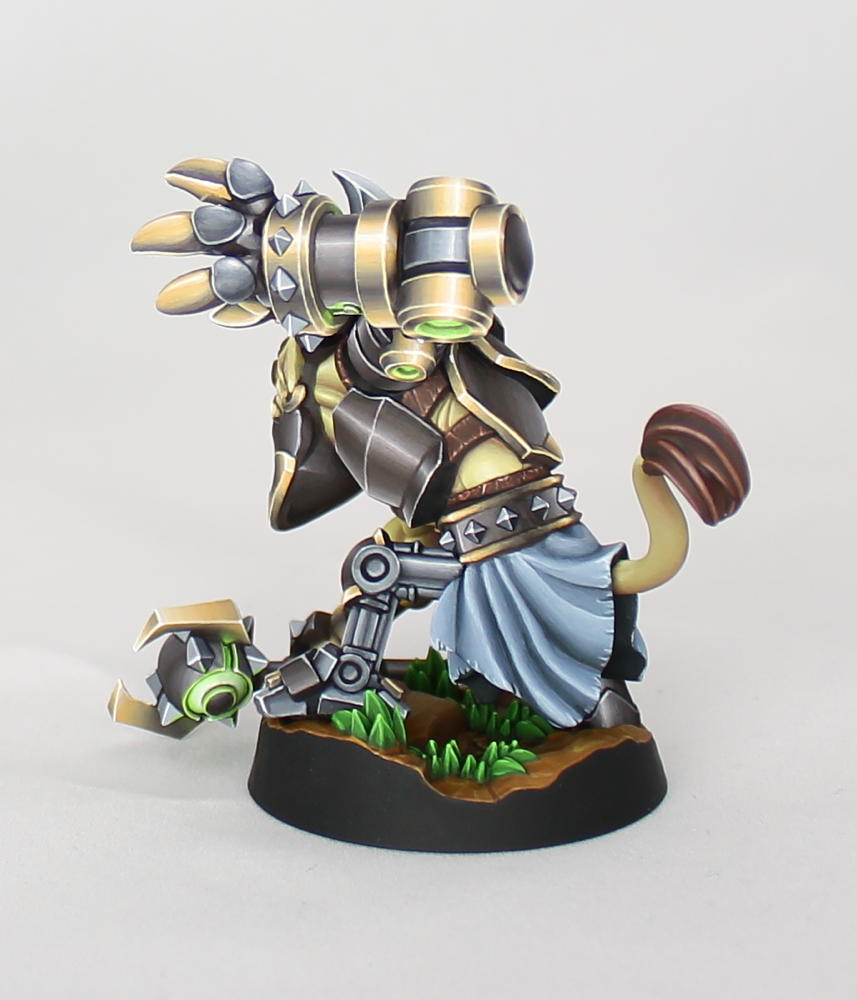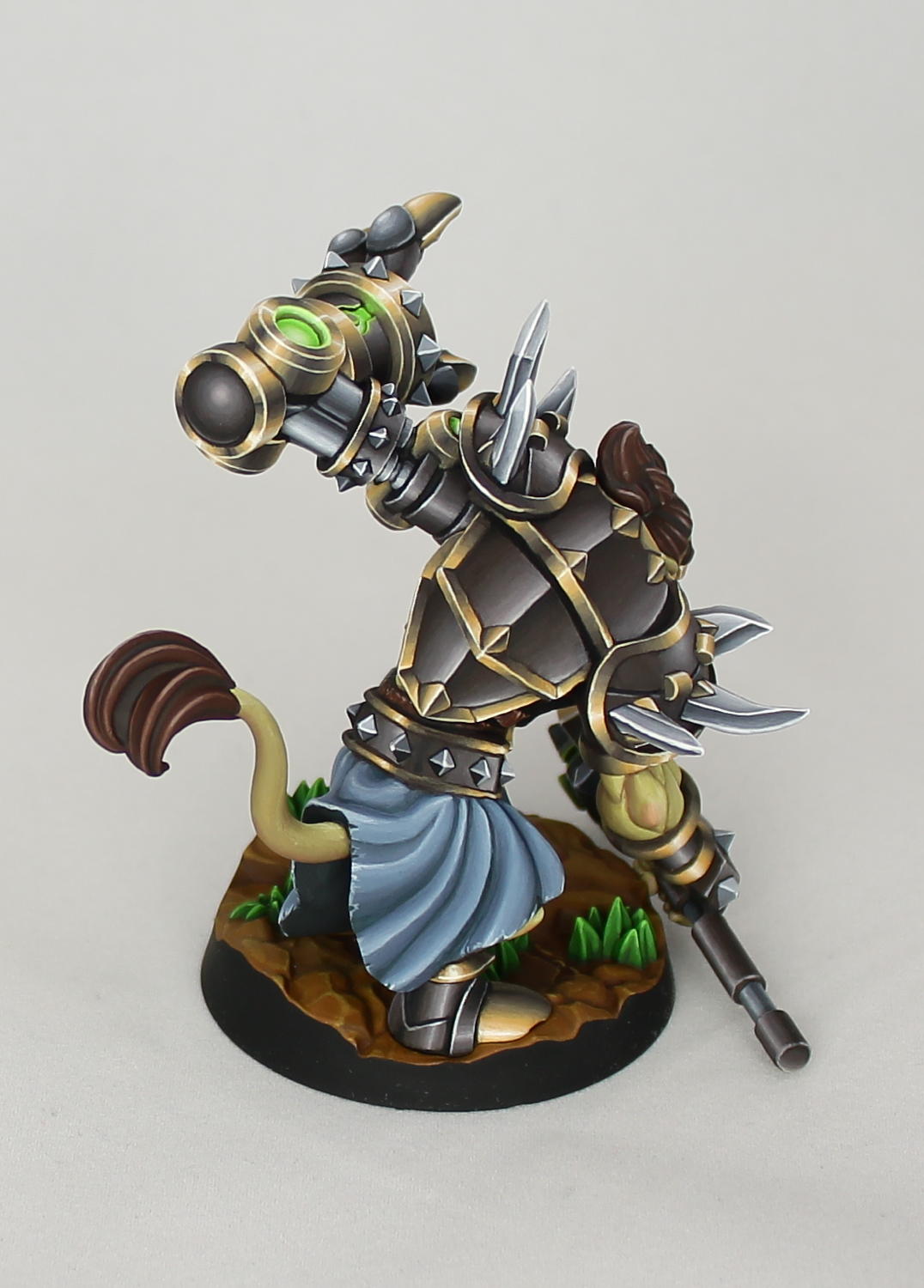Any painter can tell you that it’s generally a bad idea to start a new project before you have finished your previous projects. Most painters can also tell you that it is almost impossible to resist the temptation when a really terrific subject comes along, which is certainly the case for me with Mythic Games’s recently released Super Fantasy Brawl! I backed this game on Kickstarter, fully expecting the routine delays in fulfillment to give me time to finish my HeroQuest and Descent 2nd Edition models, giving me free reign to jump into painting these wonderful characters. Alas, the game was delivered promptly, and the bright colors and personality-filled sculpts broke my resolve.
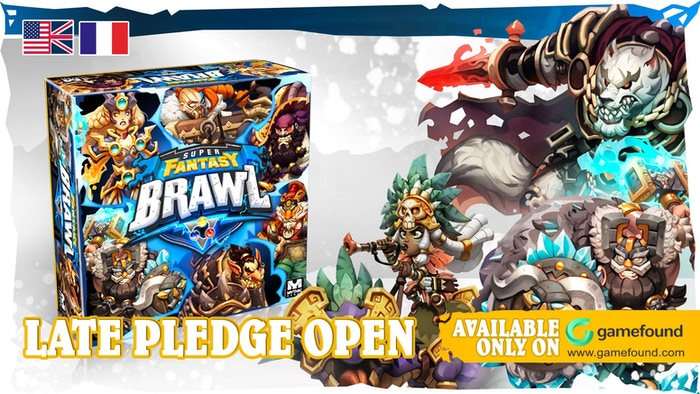
Super Fantasy Brawl is a pick-up and play arena combat game pitting one player’s team of three champions against their opponents. Each player’s turn consists of using their three “cores of magic” (tokens representing the primal forces of Creation, Destruction, and Manipulation) to power the abilities of their champions (by playing cards color-coded to match the required magical core). These abilities generally involve movement, attacks, and various support actions, with each champion excelling in different ways. For instance, the dwarf Dugrun has a lot of armor and is resistant to being moved by his attackers, while the sorceress Gwaien has little health but casts high-damage ranged attacks. The strengths of today’s subject, Kilgore the Ravager, lie not in defense or damage, but in the natural ability of Trolls to regenerate health.
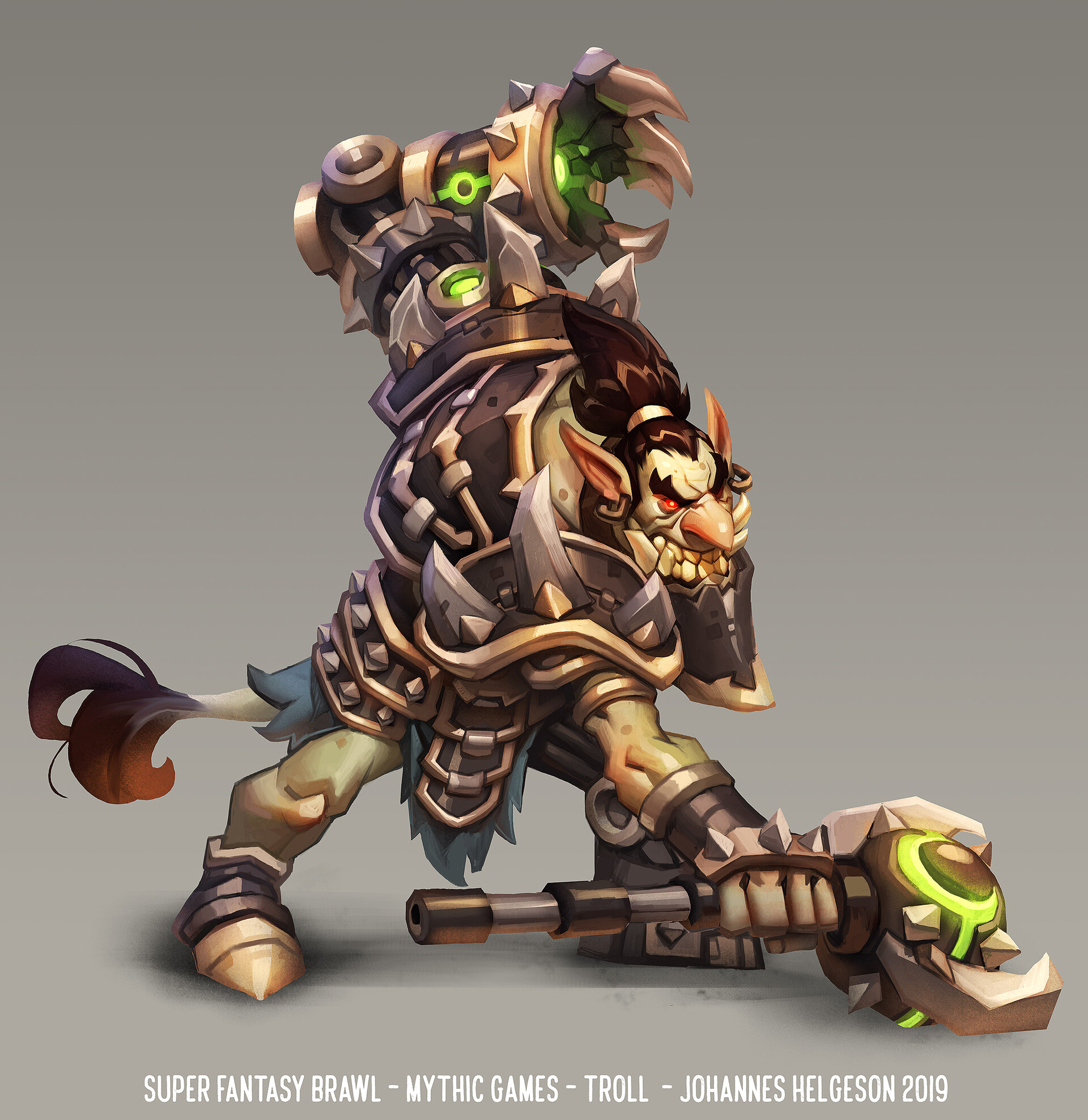
With his huge size and impressive armor, one could be forgiven for thinking Kilgore was a thuggish brute. This could not be further from the truth. Most champions’ attacks are powered by the red Core of Destruction, with modifiers that grant additional damage, targets, or harmful conditions. In contrast, most of Kilgore’s attacks are fueled by the yellow Core of Creation, either simply healing him or siphoning health from his opponent. This detail not only extends the troll’s life expectancy in the arena, but also allows a player to perform attacks with Kilgore while saving their red Core for stronger attacks from other champions.
The Ravager’s miniature is impressive. Despite some difficult mold lines, imperfect edges, and a couple of annoying gaps, the casting is rather nice for a gaming miniature. The muscles are well defined, the armor is relatively smooth, and the sculpted base is an added bonus. Strangely, the miniatures worst aspect is the same as it’s best: the pose, while being dynamic and interesting, leaves many areas very difficult to reach with a brush. To combat this issue, I chose to remove the figure from the base using a sharp blade, a drill, and a chisel. During this process, I managed to break the shaft connecting the head of his mace to his hand. This was a pretty simple fix with a couple of bits of metal tubing, but actually helped me to reach into that difficult space under his chest and chin.
In regards to his paint scheme, I attempted to mimic the official pictures as much as possible. Obviously, most of my attention was given to the armor and prosthetic limbs, with lots of blending and highlighting needed for those areas. This is my first real attempt at object source lighting on a gaming miniature, and overall I am pleased with how the glow looks. Not too strong, not too subtle… I actually even fooled myself for a second at one point, unconsciously rotating the miniature to avoid an annoying glare before realizing it was the OSL.
So much nonmetallic metal! This miniature, which I was hoping would be quick and straightforward, quickly ballooned into a months-long project. Bit-by-bit he came together, but I was very happy when an end came in sight. Back to my normal projects, but rest assured, I won’t be able to resist painting more from this line for long.
Brown Metal:
The brown metallic sections were painted using a standard non-metallic metal application of the following colors: VMC German Camo Black Brown (70.822), VGC Heavy Warmgrey (72.148), and VMC Ivory (70.918). Some VMC Black (70.950) was added to the German Camo Black Brown for the darkest shadows, and the midtones concluded with an approximate 2:1 mix of Heavy Warmgrey and German Camo Black Brown before the addition of Ivory for the highlights.
Gold:
The gold metallic sections were painted using a standard non-metallic metal application of the following colors: VMC German Camo Black Brown (70.822), VMC Desert Yellow (70.977), and VMC Ivory (70.918).
Steel:
The areas of steel were painted using a standard non-metallic metal application of the following colors: VMC Black (70.950) mixed 1:1 with VGA Armor Brown (71.041), and Schmincke Titanium White.
Skin:
The flesh was painted with a complex mix of colors. The base tone could be considered to have been VGC Dead Flesh (72.035). Shading was accomplished by blending down to VMC Khaki (70.988), followed by the addition of Vallejo Fantasy Pro Nocturna (VFPN) Burned Flesh (74.002), with some VMC German Camo Black Brown (70.822) added in the deepest shadows. VFPN Highlight Skin (74.008) was added incrementally to the Dead Flesh for highlights, followed by sparing use of VMC Ivory (70.918) for point highlights. Certain areas were also tinted slightly by glazing VFPN Reddish Flesh (74.003) over the highlights, as well as mixing Reddish Flesh into Dead Flesh and Khaki to blend it out into the normal skin.
Teeth:
The entire mouth was blocked in with VMC German Camo Black Brown (70.822). Individual teeth were base coated with VMC Green Brown (70.879). This was lightened in stages with the addition of VGC Bonewhite (72.034) followed by VMC Ivory (70.918). Final highlights to the points of the tusks were applied with Schmincke Titanium White.
Hair:
The hair was blocked in with VMC German Camo Black Brown (70.822). The large tufts of hair were then base coated with VGC Charred Brown (72.045). These tufts were highlighted with thin lines of a 1:1 mix of Charred Brown and VGC Tan (72.066), followed by point highlights with VMC Ivory (70.918) added to the previous mix.
Cloth:
The blue cloth was base coated with a 1:1 mix of VMC Dark Sea Blue (70.898) and VMC Luftwaffe Uniform WWII (70.816). Several layers were added with the incremental addition of VGC Steel Grey (72.102) to this mix, followed by the addition of VGC Wolf Grey (72.047) for highlights.
Leather:
The leather straps and belt were blocked in with VMC Black (70.950), and then base coated with a 1:1 mix of Black and VMC Flat Brown (70.984). This was lightened with the addition of VGC Parasite Brown (72.042) and stippled/mottled over the entire surface. Linear scratches were added with a highlight tone created with the addition of VGC Bonewhite (72.034) to the previous mix.
Base:
Ground:
The areas of dirt were base coated with VMC Flat Earth. Shade was added to cracks and crevices with VGC Charred Brown (72.045). Several layers of Flat Earth mixed with incremental amounts of VMC Green Brown (70.879) were added to the upturned surfaces, ending with pure Green Brown. Highlights were added with the addition of VMC Beige (70.917).
Grass:
The areas of grass were base coated with VMC Flat Green (70.968). Shade was added with a 1:1 mix of Flat Green and VMC Black (70.950). Layers were added to the individual blades with the incremental addition of VGC Escorpena Green (72.032) to the Flat Green. Highlights were then applied with pure Escorpena Green.

